Analysis of Personal and Professional Development (PPD) Plan Report
VerifiedAdded on 2020/06/06
|16
|4575
|50
Report
AI Summary
This report delves into a Personal and Professional Development (PPD) plan, outlining various aspects of self-managed learning. It explores different approaches to self-managed learning, emphasizing the importance of lifelong learning in both personal and professional contexts. The report examines the benefits of self-managed learning for individuals and organizations, followed by an assessment of current skills and competencies against professional standards. It identifies developmental needs, proposes activities to meet these needs, and outlines development opportunities. The report also includes a PPD plan based on determined needs, detailing learning objectives, current proficiency, target proficiency, development opportunities, and evaluation criteria. Furthermore, it discusses the implementation process, documentation of activities, and evaluation of learning against set objectives, culminating in a PPD plan based on evaluation and feedback. The report concludes with a work-based problem, its solution, and the application of different learning styles and time management strategies.

PERSONAL
AND
PROFESSIONAL
DEVELOPMENT
AND
PROFESSIONAL
DEVELOPMENT
Paraphrase This Document
Need a fresh take? Get an instant paraphrase of this document with our AI Paraphraser
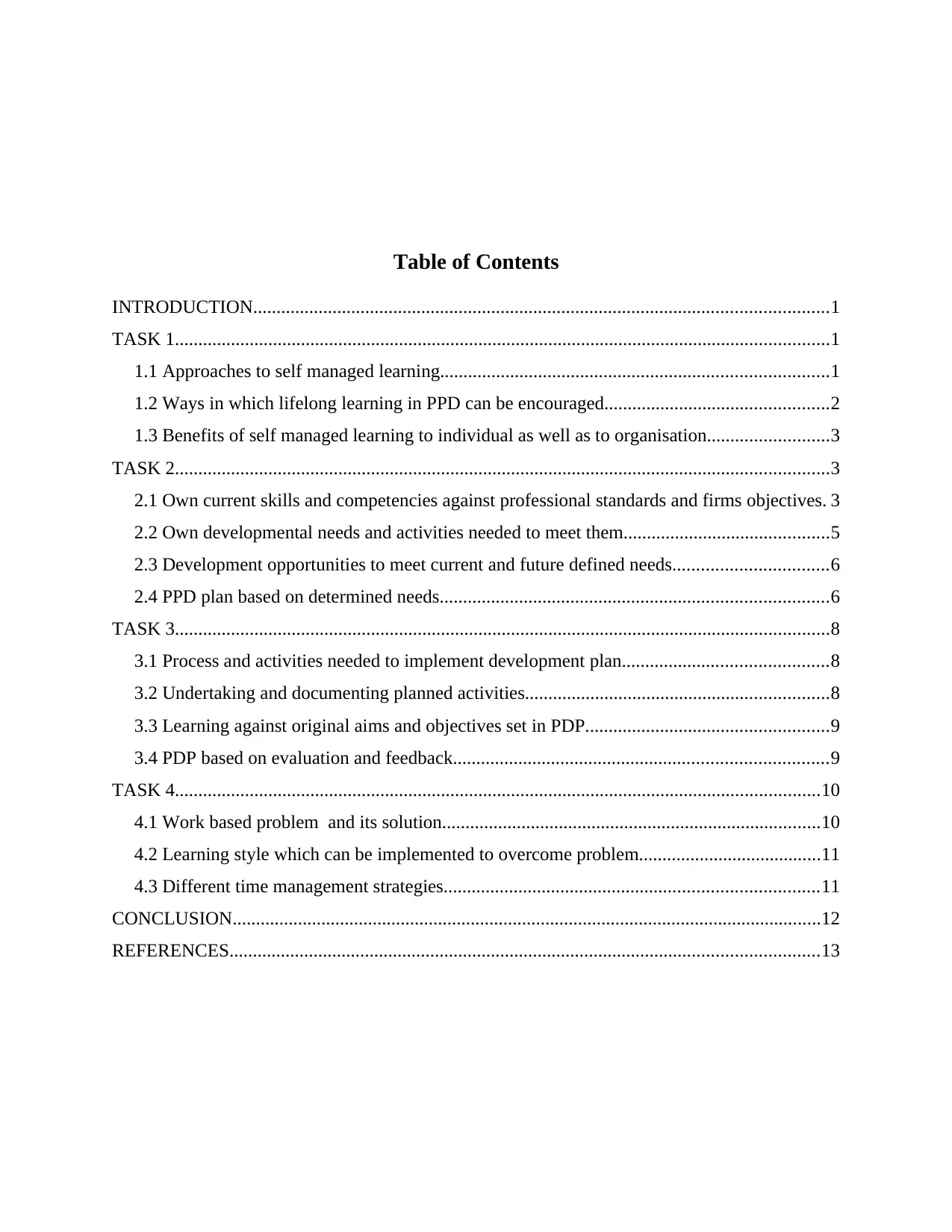
Table of Contents
INTRODUCTION...........................................................................................................................1
TASK 1............................................................................................................................................1
1.1 Approaches to self managed learning...................................................................................1
1.2 Ways in which lifelong learning in PPD can be encouraged................................................2
1.3 Benefits of self managed learning to individual as well as to organisation..........................3
TASK 2............................................................................................................................................3
2.1 Own current skills and competencies against professional standards and firms objectives. 3
2.2 Own developmental needs and activities needed to meet them............................................5
2.3 Development opportunities to meet current and future defined needs.................................6
2.4 PPD plan based on determined needs...................................................................................6
TASK 3............................................................................................................................................8
3.1 Process and activities needed to implement development plan............................................8
3.2 Undertaking and documenting planned activities.................................................................8
3.3 Learning against original aims and objectives set in PDP....................................................9
3.4 PDP based on evaluation and feedback................................................................................9
TASK 4..........................................................................................................................................10
4.1 Work based problem and its solution.................................................................................10
4.2 Learning style which can be implemented to overcome problem.......................................11
4.3 Different time management strategies................................................................................11
CONCLUSION..............................................................................................................................12
REFERENCES..............................................................................................................................13
INTRODUCTION...........................................................................................................................1
TASK 1............................................................................................................................................1
1.1 Approaches to self managed learning...................................................................................1
1.2 Ways in which lifelong learning in PPD can be encouraged................................................2
1.3 Benefits of self managed learning to individual as well as to organisation..........................3
TASK 2............................................................................................................................................3
2.1 Own current skills and competencies against professional standards and firms objectives. 3
2.2 Own developmental needs and activities needed to meet them............................................5
2.3 Development opportunities to meet current and future defined needs.................................6
2.4 PPD plan based on determined needs...................................................................................6
TASK 3............................................................................................................................................8
3.1 Process and activities needed to implement development plan............................................8
3.2 Undertaking and documenting planned activities.................................................................8
3.3 Learning against original aims and objectives set in PDP....................................................9
3.4 PDP based on evaluation and feedback................................................................................9
TASK 4..........................................................................................................................................10
4.1 Work based problem and its solution.................................................................................10
4.2 Learning style which can be implemented to overcome problem.......................................11
4.3 Different time management strategies................................................................................11
CONCLUSION..............................................................................................................................12
REFERENCES..............................................................................................................................13

INTRODUCTION
In the age of globalisation where world has transformed into a global village, competition
has not only increased in between enterprises but have also effected the lives of employees both
in personal and professional ways. Competition has raised the demand for individuals to increase
their skills by applying different approaches to Personal and professional development (Avalos,
2011). Different developmental strategies in this context can help individual in enhancing their
position in the firm as well as encountering the difficulties in the path of Success. This report
highlights need of workers to make their personal and professional development plan for
themselves. It also provides idea about the ways in which it can be achieved.
TASK 1
1.1 Approaches to self managed learning.
One of the best ways of learning is to learn through self management. It can be highly
crucial in situations where there is unavailability of local mentors or guidance (Beach, 2012). In
this style of learning there are several approaches that could be used so as to make this process
easier. Few of these learning approaches are as follows:
Books, articles and journals: It is one of the primary and oldest approach to self
managed learning. Since contents of these sources are highly detailed, conceptualised as
well as coherent hence can be one of the most effective ways to this kind of learning.
Social media: It is a platform for interaction and is one of the best ways in modern times
to self managed learning. There is a demerit associated with it is that it can provide false
knowledge sometimes.
Internet: In the modern era of technology where internet has reached to almost every
hands, has empowered people to use this approach as a medium for managed learning.
One of the biggest positive point with this kind of learning is that it is cheaper and can be
accessed by technological gadgets at any time any place.
Seminars, Workshop or Conferences: These are programmes that can be highly
beneficial for managing self learning. An individual can learn from expertise of different
field by inheriting their shared experiences and interacting with them on the topics they
want to learn.
1
In the age of globalisation where world has transformed into a global village, competition
has not only increased in between enterprises but have also effected the lives of employees both
in personal and professional ways. Competition has raised the demand for individuals to increase
their skills by applying different approaches to Personal and professional development (Avalos,
2011). Different developmental strategies in this context can help individual in enhancing their
position in the firm as well as encountering the difficulties in the path of Success. This report
highlights need of workers to make their personal and professional development plan for
themselves. It also provides idea about the ways in which it can be achieved.
TASK 1
1.1 Approaches to self managed learning.
One of the best ways of learning is to learn through self management. It can be highly
crucial in situations where there is unavailability of local mentors or guidance (Beach, 2012). In
this style of learning there are several approaches that could be used so as to make this process
easier. Few of these learning approaches are as follows:
Books, articles and journals: It is one of the primary and oldest approach to self
managed learning. Since contents of these sources are highly detailed, conceptualised as
well as coherent hence can be one of the most effective ways to this kind of learning.
Social media: It is a platform for interaction and is one of the best ways in modern times
to self managed learning. There is a demerit associated with it is that it can provide false
knowledge sometimes.
Internet: In the modern era of technology where internet has reached to almost every
hands, has empowered people to use this approach as a medium for managed learning.
One of the biggest positive point with this kind of learning is that it is cheaper and can be
accessed by technological gadgets at any time any place.
Seminars, Workshop or Conferences: These are programmes that can be highly
beneficial for managing self learning. An individual can learn from expertise of different
field by inheriting their shared experiences and interacting with them on the topics they
want to learn.
1
⊘ This is a preview!⊘
Do you want full access?
Subscribe today to unlock all pages.

Trusted by 1+ million students worldwide
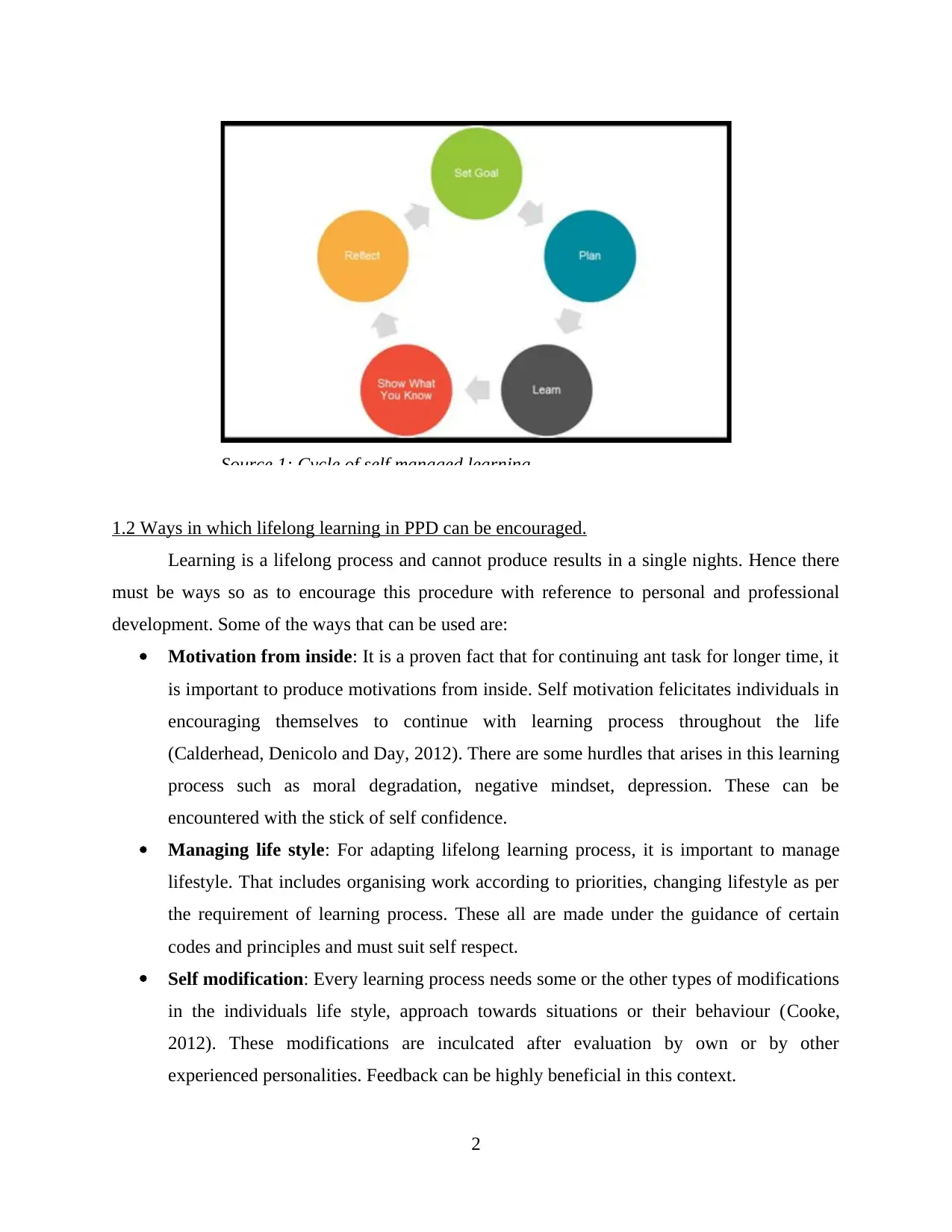
1.2 Ways in which lifelong learning in PPD can be encouraged.
Learning is a lifelong process and cannot produce results in a single nights. Hence there
must be ways so as to encourage this procedure with reference to personal and professional
development. Some of the ways that can be used are:
Motivation from inside: It is a proven fact that for continuing ant task for longer time, it
is important to produce motivations from inside. Self motivation felicitates individuals in
encouraging themselves to continue with learning process throughout the life
(Calderhead, Denicolo and Day, 2012). There are some hurdles that arises in this learning
process such as moral degradation, negative mindset, depression. These can be
encountered with the stick of self confidence.
Managing life style: For adapting lifelong learning process, it is important to manage
lifestyle. That includes organising work according to priorities, changing lifestyle as per
the requirement of learning process. These all are made under the guidance of certain
codes and principles and must suit self respect.
Self modification: Every learning process needs some or the other types of modifications
in the individuals life style, approach towards situations or their behaviour (Cooke,
2012). These modifications are inculcated after evaluation by own or by other
experienced personalities. Feedback can be highly beneficial in this context.
2
Source 1: Cycle of self managed learning
Learning is a lifelong process and cannot produce results in a single nights. Hence there
must be ways so as to encourage this procedure with reference to personal and professional
development. Some of the ways that can be used are:
Motivation from inside: It is a proven fact that for continuing ant task for longer time, it
is important to produce motivations from inside. Self motivation felicitates individuals in
encouraging themselves to continue with learning process throughout the life
(Calderhead, Denicolo and Day, 2012). There are some hurdles that arises in this learning
process such as moral degradation, negative mindset, depression. These can be
encountered with the stick of self confidence.
Managing life style: For adapting lifelong learning process, it is important to manage
lifestyle. That includes organising work according to priorities, changing lifestyle as per
the requirement of learning process. These all are made under the guidance of certain
codes and principles and must suit self respect.
Self modification: Every learning process needs some or the other types of modifications
in the individuals life style, approach towards situations or their behaviour (Cooke,
2012). These modifications are inculcated after evaluation by own or by other
experienced personalities. Feedback can be highly beneficial in this context.
2
Source 1: Cycle of self managed learning
Paraphrase This Document
Need a fresh take? Get an instant paraphrase of this document with our AI Paraphraser

Self monitoring: For an individual it become crucial to have knowledge about their
strength and core competencies. Monitoring is done on a larger time scale in a discrete
time frames that too on continues basis. Individuals characteristics, traits, capabilities and
skills can be determined using this method.
1.3 Benefits of self managed learning to individual as well as to organisation
Self managed learning is one of the best methods for achieving success. There are list of
benefits that are attached with this learning procedure. It is comparatively reliable and easier to
adapt when compared with other methodologies (Desimone, 2011). It may takes longer time but
is highly effective in adding value to PPD plans. Its benefit is not only subjected to individuals
but also to organisations. These benefits are underlined in the below mentioned points.
Benefits to individuals:
It helps individuals in competing with their co-workers at the workplace.
It results in personality growth of worker that assists them in grabbing opportunities
available at workplaces.
It helps in collecting thing that be useful for other also in future.
Benefits to organisations
Through self managed learning skills are developed which results in higher productivity.
Since the efficiency of employee is increased by this learning hence it results in effective
utilisation of resources.
When self managed learning is applied then there is less requirement of costly training
sessions which ultimately saves the money of the employer.
TASK 2
2.1 Own current skills and competencies against professional standards and firms objectives.
There are certain standards that are present at any organisation regarding the skills of an
employee. These are the minimum standards that must be present in skill set of any employee. It
is essential for the workers to evaluate their own skills against the defined company standards
(Eros, 2011). Some of the standard deciding criteria are as follows:
Conceptual skill: These skills needs to be present with every individual since it helps to
determine the opportunities present at firm, forecasting and evaluating threats by boosting
up the improvement process in future. When person is having conceptualised skills
3
strength and core competencies. Monitoring is done on a larger time scale in a discrete
time frames that too on continues basis. Individuals characteristics, traits, capabilities and
skills can be determined using this method.
1.3 Benefits of self managed learning to individual as well as to organisation
Self managed learning is one of the best methods for achieving success. There are list of
benefits that are attached with this learning procedure. It is comparatively reliable and easier to
adapt when compared with other methodologies (Desimone, 2011). It may takes longer time but
is highly effective in adding value to PPD plans. Its benefit is not only subjected to individuals
but also to organisations. These benefits are underlined in the below mentioned points.
Benefits to individuals:
It helps individuals in competing with their co-workers at the workplace.
It results in personality growth of worker that assists them in grabbing opportunities
available at workplaces.
It helps in collecting thing that be useful for other also in future.
Benefits to organisations
Through self managed learning skills are developed which results in higher productivity.
Since the efficiency of employee is increased by this learning hence it results in effective
utilisation of resources.
When self managed learning is applied then there is less requirement of costly training
sessions which ultimately saves the money of the employer.
TASK 2
2.1 Own current skills and competencies against professional standards and firms objectives.
There are certain standards that are present at any organisation regarding the skills of an
employee. These are the minimum standards that must be present in skill set of any employee. It
is essential for the workers to evaluate their own skills against the defined company standards
(Eros, 2011). Some of the standard deciding criteria are as follows:
Conceptual skill: These skills needs to be present with every individual since it helps to
determine the opportunities present at firm, forecasting and evaluating threats by boosting
up the improvement process in future. When person is having conceptualised skills
3
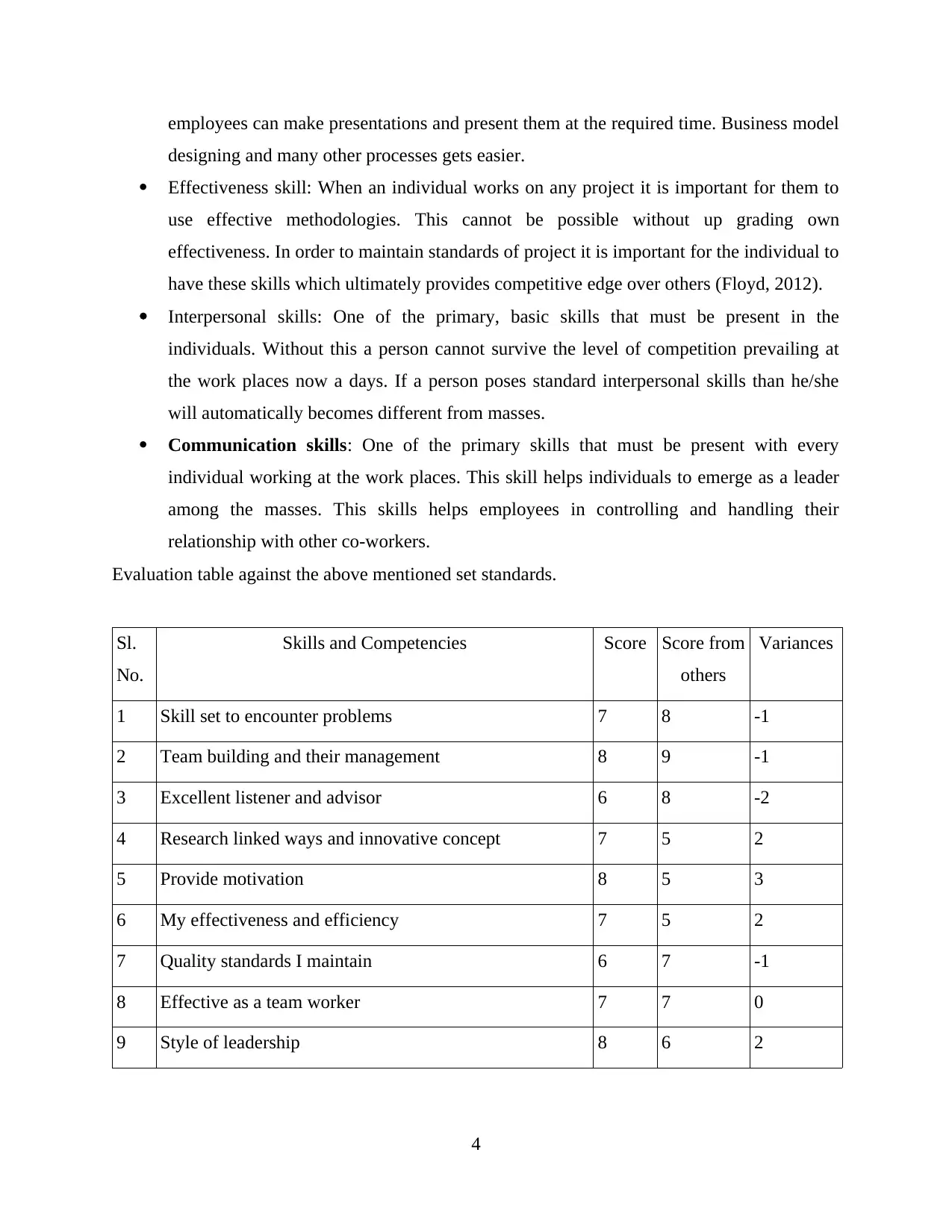
employees can make presentations and present them at the required time. Business model
designing and many other processes gets easier.
Effectiveness skill: When an individual works on any project it is important for them to
use effective methodologies. This cannot be possible without up grading own
effectiveness. In order to maintain standards of project it is important for the individual to
have these skills which ultimately provides competitive edge over others (Floyd, 2012).
Interpersonal skills: One of the primary, basic skills that must be present in the
individuals. Without this a person cannot survive the level of competition prevailing at
the work places now a days. If a person poses standard interpersonal skills than he/she
will automatically becomes different from masses.
Communication skills: One of the primary skills that must be present with every
individual working at the work places. This skill helps individuals to emerge as a leader
among the masses. This skills helps employees in controlling and handling their
relationship with other co-workers.
Evaluation table against the above mentioned set standards.
Sl.
No.
Skills and Competencies Score Score from
others
Variances
1 Skill set to encounter problems 7 8 -1
2 Team building and their management 8 9 -1
3 Excellent listener and advisor 6 8 -2
4 Research linked ways and innovative concept 7 5 2
5 Provide motivation 8 5 3
6 My effectiveness and efficiency 7 5 2
7 Quality standards I maintain 6 7 -1
8 Effective as a team worker 7 7 0
9 Style of leadership 8 6 2
4
designing and many other processes gets easier.
Effectiveness skill: When an individual works on any project it is important for them to
use effective methodologies. This cannot be possible without up grading own
effectiveness. In order to maintain standards of project it is important for the individual to
have these skills which ultimately provides competitive edge over others (Floyd, 2012).
Interpersonal skills: One of the primary, basic skills that must be present in the
individuals. Without this a person cannot survive the level of competition prevailing at
the work places now a days. If a person poses standard interpersonal skills than he/she
will automatically becomes different from masses.
Communication skills: One of the primary skills that must be present with every
individual working at the work places. This skill helps individuals to emerge as a leader
among the masses. This skills helps employees in controlling and handling their
relationship with other co-workers.
Evaluation table against the above mentioned set standards.
Sl.
No.
Skills and Competencies Score Score from
others
Variances
1 Skill set to encounter problems 7 8 -1
2 Team building and their management 8 9 -1
3 Excellent listener and advisor 6 8 -2
4 Research linked ways and innovative concept 7 5 2
5 Provide motivation 8 5 3
6 My effectiveness and efficiency 7 5 2
7 Quality standards I maintain 6 7 -1
8 Effective as a team worker 7 7 0
9 Style of leadership 8 6 2
4
⊘ This is a preview!⊘
Do you want full access?
Subscribe today to unlock all pages.

Trusted by 1+ million students worldwide
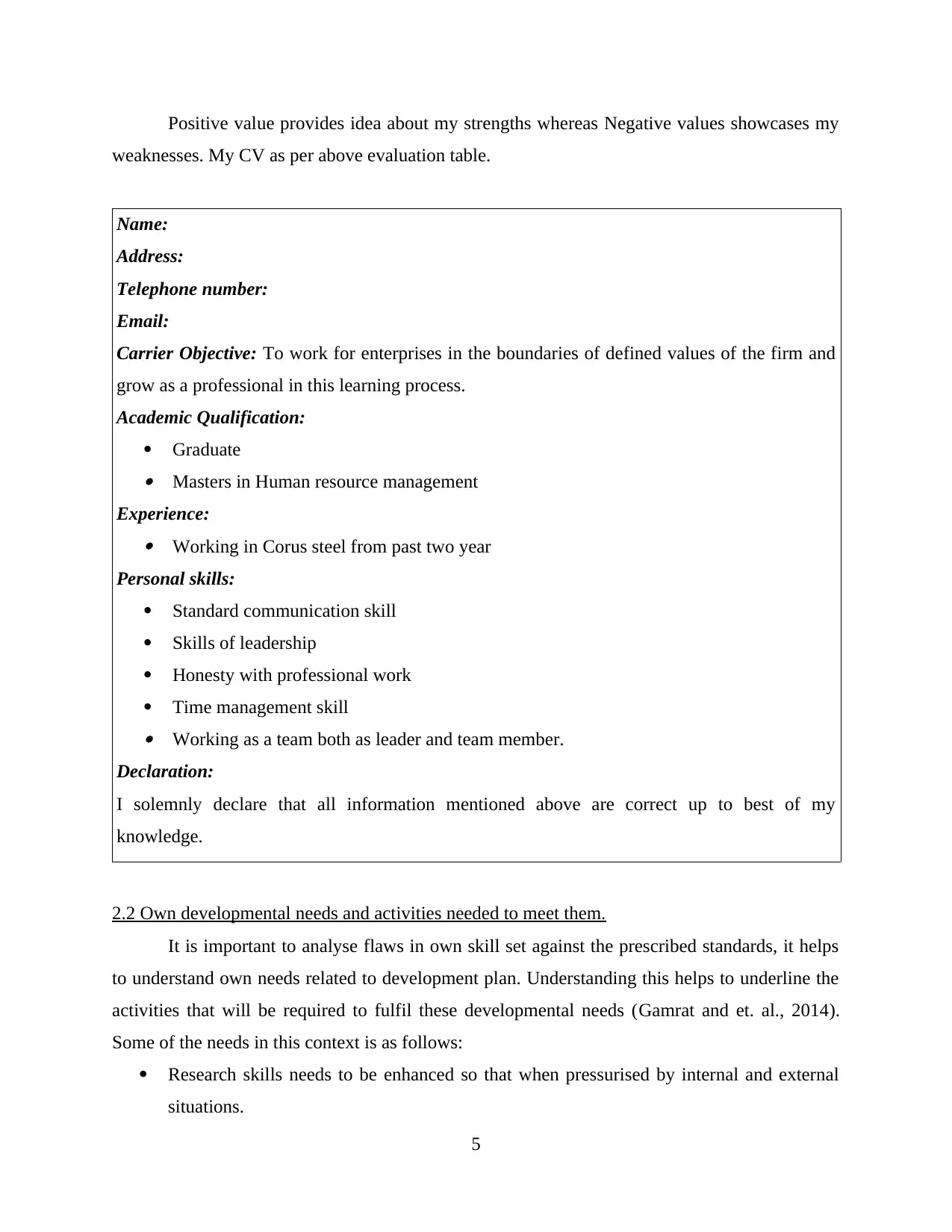
Positive value provides idea about my strengths whereas Negative values showcases my
weaknesses. My CV as per above evaluation table.
Name:
Address:
Telephone number:
Email:
Carrier Objective: To work for enterprises in the boundaries of defined values of the firm and
grow as a professional in this learning process.
Academic Qualification:
Graduate Masters in Human resource management
Experience: Working in Corus steel from past two year
Personal skills:
Standard communication skill
Skills of leadership
Honesty with professional work
Time management skill Working as a team both as leader and team member.
Declaration:
I solemnly declare that all information mentioned above are correct up to best of my
knowledge.
2.2 Own developmental needs and activities needed to meet them.
It is important to analyse flaws in own skill set against the prescribed standards, it helps
to understand own needs related to development plan. Understanding this helps to underline the
activities that will be required to fulfil these developmental needs (Gamrat and et. al., 2014).
Some of the needs in this context is as follows:
Research skills needs to be enhanced so that when pressurised by internal and external
situations.
5
weaknesses. My CV as per above evaluation table.
Name:
Address:
Telephone number:
Email:
Carrier Objective: To work for enterprises in the boundaries of defined values of the firm and
grow as a professional in this learning process.
Academic Qualification:
Graduate Masters in Human resource management
Experience: Working in Corus steel from past two year
Personal skills:
Standard communication skill
Skills of leadership
Honesty with professional work
Time management skill Working as a team both as leader and team member.
Declaration:
I solemnly declare that all information mentioned above are correct up to best of my
knowledge.
2.2 Own developmental needs and activities needed to meet them.
It is important to analyse flaws in own skill set against the prescribed standards, it helps
to understand own needs related to development plan. Understanding this helps to underline the
activities that will be required to fulfil these developmental needs (Gamrat and et. al., 2014).
Some of the needs in this context is as follows:
Research skills needs to be enhanced so that when pressurised by internal and external
situations.
5
Paraphrase This Document
Need a fresh take? Get an instant paraphrase of this document with our AI Paraphraser
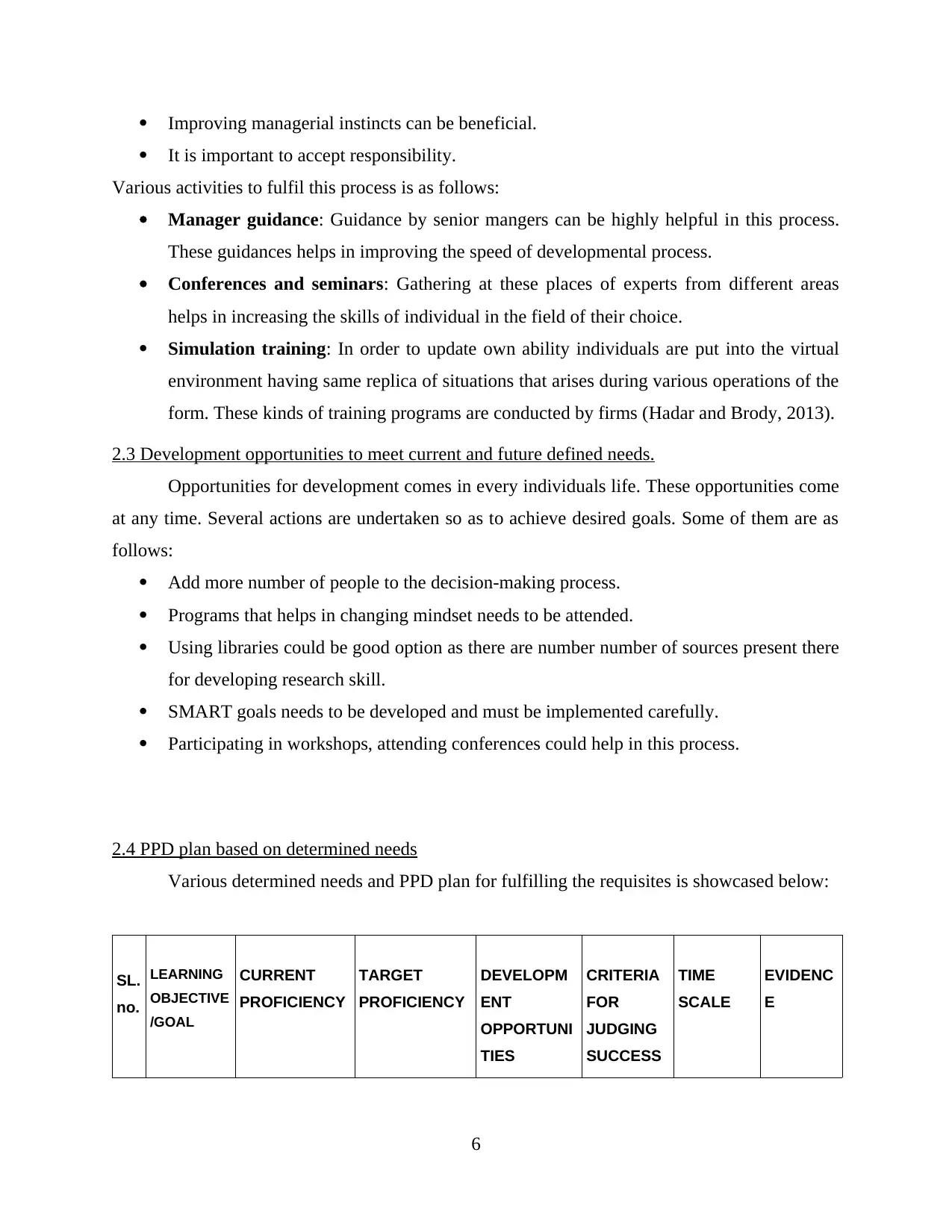
Improving managerial instincts can be beneficial.
It is important to accept responsibility.
Various activities to fulfil this process is as follows:
Manager guidance: Guidance by senior mangers can be highly helpful in this process.
These guidances helps in improving the speed of developmental process.
Conferences and seminars: Gathering at these places of experts from different areas
helps in increasing the skills of individual in the field of their choice.
Simulation training: In order to update own ability individuals are put into the virtual
environment having same replica of situations that arises during various operations of the
form. These kinds of training programs are conducted by firms (Hadar and Brody, 2013).
2.3 Development opportunities to meet current and future defined needs.
Opportunities for development comes in every individuals life. These opportunities come
at any time. Several actions are undertaken so as to achieve desired goals. Some of them are as
follows:
Add more number of people to the decision-making process.
Programs that helps in changing mindset needs to be attended.
Using libraries could be good option as there are number number of sources present there
for developing research skill.
SMART goals needs to be developed and must be implemented carefully.
Participating in workshops, attending conferences could help in this process.
2.4 PPD plan based on determined needs
Various determined needs and PPD plan for fulfilling the requisites is showcased below:
SL.
no.
LEARNING
OBJECTIVE
/GOAL
CURRENT
PROFICIENCY
TARGET
PROFICIENCY
DEVELOPM
ENT
OPPORTUNI
TIES
CRITERIA
FOR
JUDGING
SUCCESS
TIME
SCALE
EVIDENC
E
6
It is important to accept responsibility.
Various activities to fulfil this process is as follows:
Manager guidance: Guidance by senior mangers can be highly helpful in this process.
These guidances helps in improving the speed of developmental process.
Conferences and seminars: Gathering at these places of experts from different areas
helps in increasing the skills of individual in the field of their choice.
Simulation training: In order to update own ability individuals are put into the virtual
environment having same replica of situations that arises during various operations of the
form. These kinds of training programs are conducted by firms (Hadar and Brody, 2013).
2.3 Development opportunities to meet current and future defined needs.
Opportunities for development comes in every individuals life. These opportunities come
at any time. Several actions are undertaken so as to achieve desired goals. Some of them are as
follows:
Add more number of people to the decision-making process.
Programs that helps in changing mindset needs to be attended.
Using libraries could be good option as there are number number of sources present there
for developing research skill.
SMART goals needs to be developed and must be implemented carefully.
Participating in workshops, attending conferences could help in this process.
2.4 PPD plan based on determined needs
Various determined needs and PPD plan for fulfilling the requisites is showcased below:
SL.
no.
LEARNING
OBJECTIVE
/GOAL
CURRENT
PROFICIENCY
TARGET
PROFICIENCY
DEVELOPM
ENT
OPPORTUNI
TIES
CRITERIA
FOR
JUDGING
SUCCESS
TIME
SCALE
EVIDENC
E
6
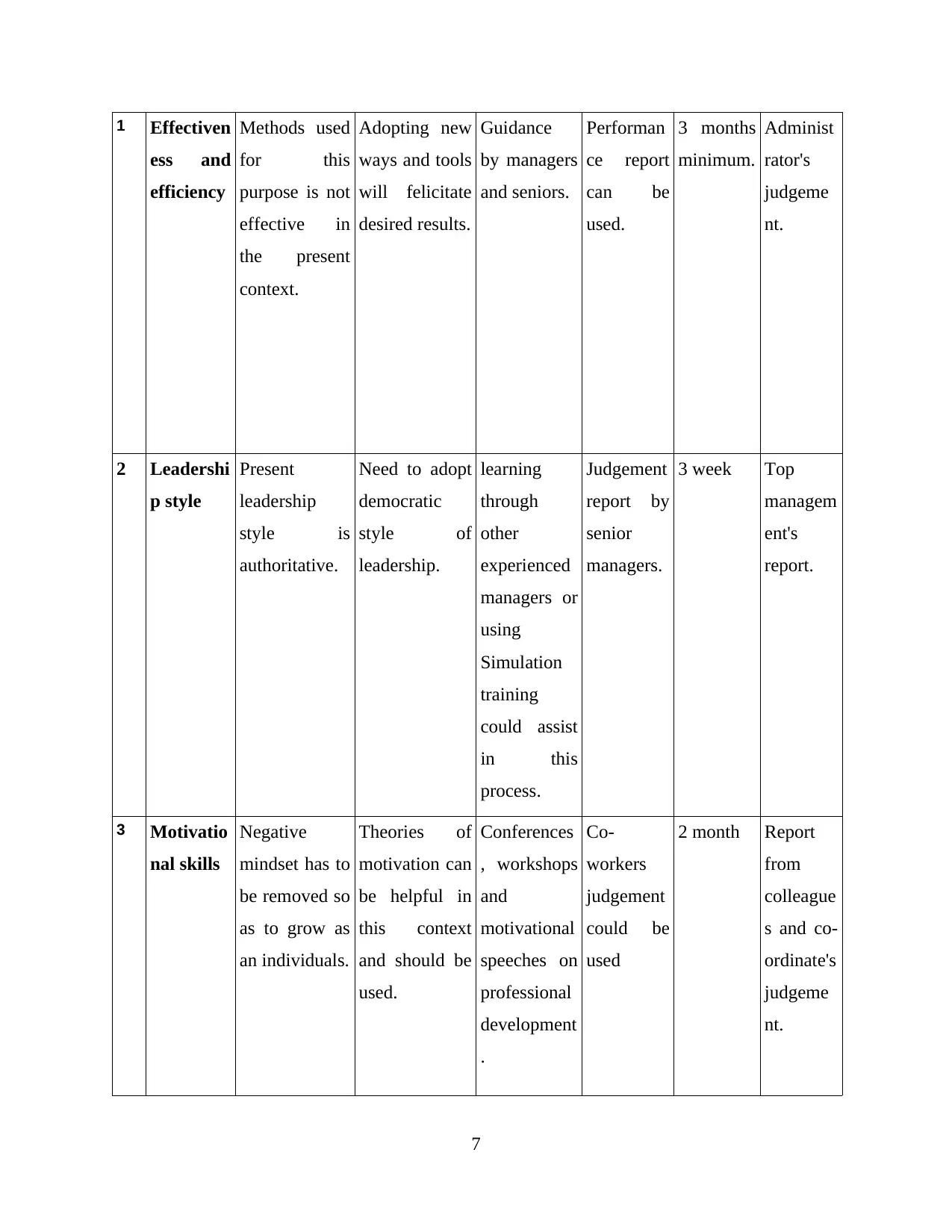
1 Effectiven
ess and
efficiency
Methods used
for this
purpose is not
effective in
the present
context.
Adopting new
ways and tools
will felicitate
desired results.
Guidance
by managers
and seniors.
Performan
ce report
can be
used.
3 months
minimum.
Administ
rator's
judgeme
nt.
2 Leadershi
p style
Present
leadership
style is
authoritative.
Need to adopt
democratic
style of
leadership.
learning
through
other
experienced
managers or
using
Simulation
training
could assist
in this
process.
Judgement
report by
senior
managers.
3 week Top
managem
ent's
report.
3 Motivatio
nal skills
Negative
mindset has to
be removed so
as to grow as
an individuals.
Theories of
motivation can
be helpful in
this context
and should be
used.
Conferences
, workshops
and
motivational
speeches on
professional
development
.
Co-
workers
judgement
could be
used
2 month Report
from
colleague
s and co-
ordinate's
judgeme
nt.
7
ess and
efficiency
Methods used
for this
purpose is not
effective in
the present
context.
Adopting new
ways and tools
will felicitate
desired results.
Guidance
by managers
and seniors.
Performan
ce report
can be
used.
3 months
minimum.
Administ
rator's
judgeme
nt.
2 Leadershi
p style
Present
leadership
style is
authoritative.
Need to adopt
democratic
style of
leadership.
learning
through
other
experienced
managers or
using
Simulation
training
could assist
in this
process.
Judgement
report by
senior
managers.
3 week Top
managem
ent's
report.
3 Motivatio
nal skills
Negative
mindset has to
be removed so
as to grow as
an individuals.
Theories of
motivation can
be helpful in
this context
and should be
used.
Conferences
, workshops
and
motivational
speeches on
professional
development
.
Co-
workers
judgement
could be
used
2 month Report
from
colleague
s and co-
ordinate's
judgeme
nt.
7
⊘ This is a preview!⊘
Do you want full access?
Subscribe today to unlock all pages.

Trusted by 1+ million students worldwide
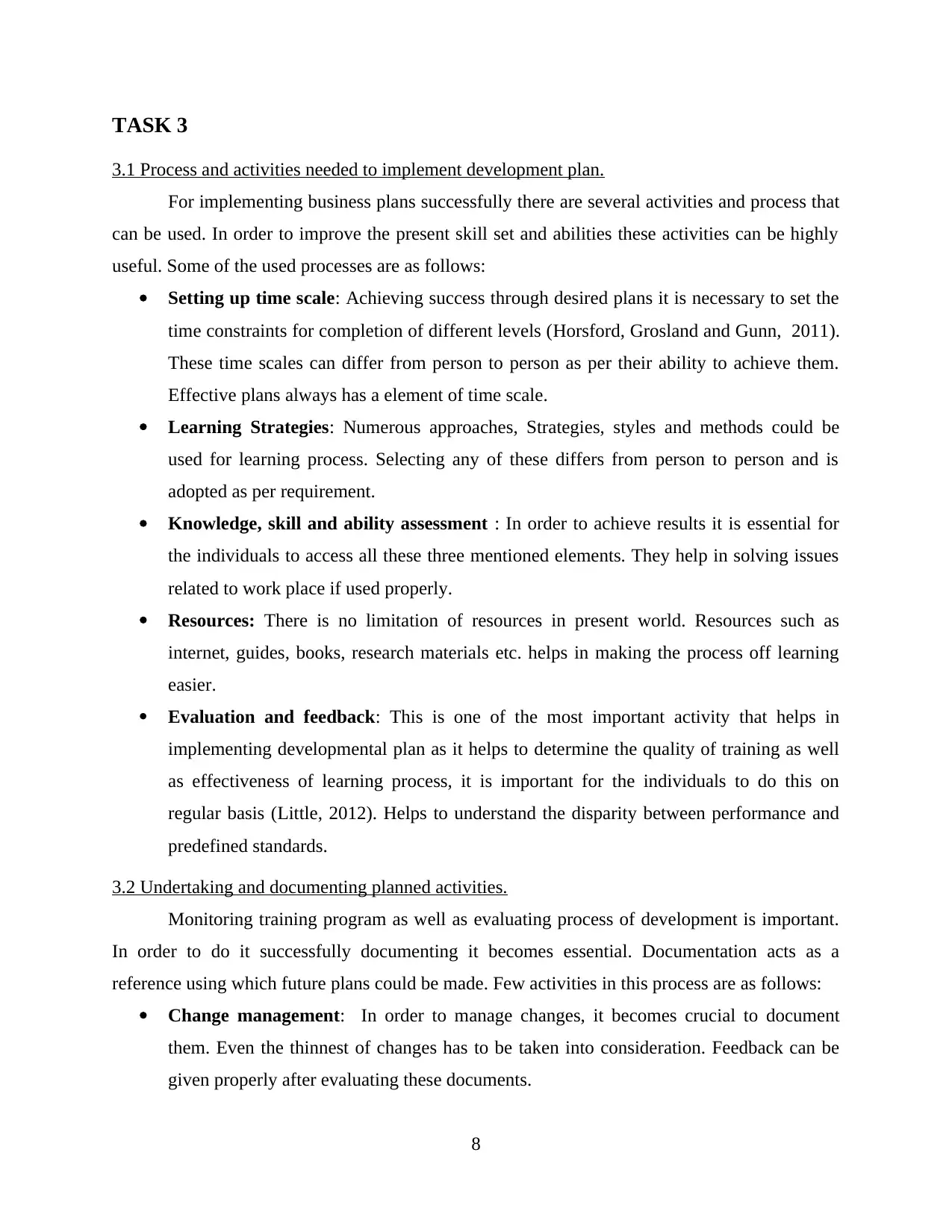
TASK 3
3.1 Process and activities needed to implement development plan.
For implementing business plans successfully there are several activities and process that
can be used. In order to improve the present skill set and abilities these activities can be highly
useful. Some of the used processes are as follows:
Setting up time scale: Achieving success through desired plans it is necessary to set the
time constraints for completion of different levels (Horsford, Grosland and Gunn, 2011).
These time scales can differ from person to person as per their ability to achieve them.
Effective plans always has a element of time scale.
Learning Strategies: Numerous approaches, Strategies, styles and methods could be
used for learning process. Selecting any of these differs from person to person and is
adopted as per requirement.
Knowledge, skill and ability assessment : In order to achieve results it is essential for
the individuals to access all these three mentioned elements. They help in solving issues
related to work place if used properly.
Resources: There is no limitation of resources in present world. Resources such as
internet, guides, books, research materials etc. helps in making the process off learning
easier.
Evaluation and feedback: This is one of the most important activity that helps in
implementing developmental plan as it helps to determine the quality of training as well
as effectiveness of learning process, it is important for the individuals to do this on
regular basis (Little, 2012). Helps to understand the disparity between performance and
predefined standards.
3.2 Undertaking and documenting planned activities.
Monitoring training program as well as evaluating process of development is important.
In order to do it successfully documenting it becomes essential. Documentation acts as a
reference using which future plans could be made. Few activities in this process are as follows:
Change management: In order to manage changes, it becomes crucial to document
them. Even the thinnest of changes has to be taken into consideration. Feedback can be
given properly after evaluating these documents.
8
3.1 Process and activities needed to implement development plan.
For implementing business plans successfully there are several activities and process that
can be used. In order to improve the present skill set and abilities these activities can be highly
useful. Some of the used processes are as follows:
Setting up time scale: Achieving success through desired plans it is necessary to set the
time constraints for completion of different levels (Horsford, Grosland and Gunn, 2011).
These time scales can differ from person to person as per their ability to achieve them.
Effective plans always has a element of time scale.
Learning Strategies: Numerous approaches, Strategies, styles and methods could be
used for learning process. Selecting any of these differs from person to person and is
adopted as per requirement.
Knowledge, skill and ability assessment : In order to achieve results it is essential for
the individuals to access all these three mentioned elements. They help in solving issues
related to work place if used properly.
Resources: There is no limitation of resources in present world. Resources such as
internet, guides, books, research materials etc. helps in making the process off learning
easier.
Evaluation and feedback: This is one of the most important activity that helps in
implementing developmental plan as it helps to determine the quality of training as well
as effectiveness of learning process, it is important for the individuals to do this on
regular basis (Little, 2012). Helps to understand the disparity between performance and
predefined standards.
3.2 Undertaking and documenting planned activities.
Monitoring training program as well as evaluating process of development is important.
In order to do it successfully documenting it becomes essential. Documentation acts as a
reference using which future plans could be made. Few activities in this process are as follows:
Change management: In order to manage changes, it becomes crucial to document
them. Even the thinnest of changes has to be taken into consideration. Feedback can be
given properly after evaluating these documents.
8
Paraphrase This Document
Need a fresh take? Get an instant paraphrase of this document with our AI Paraphraser
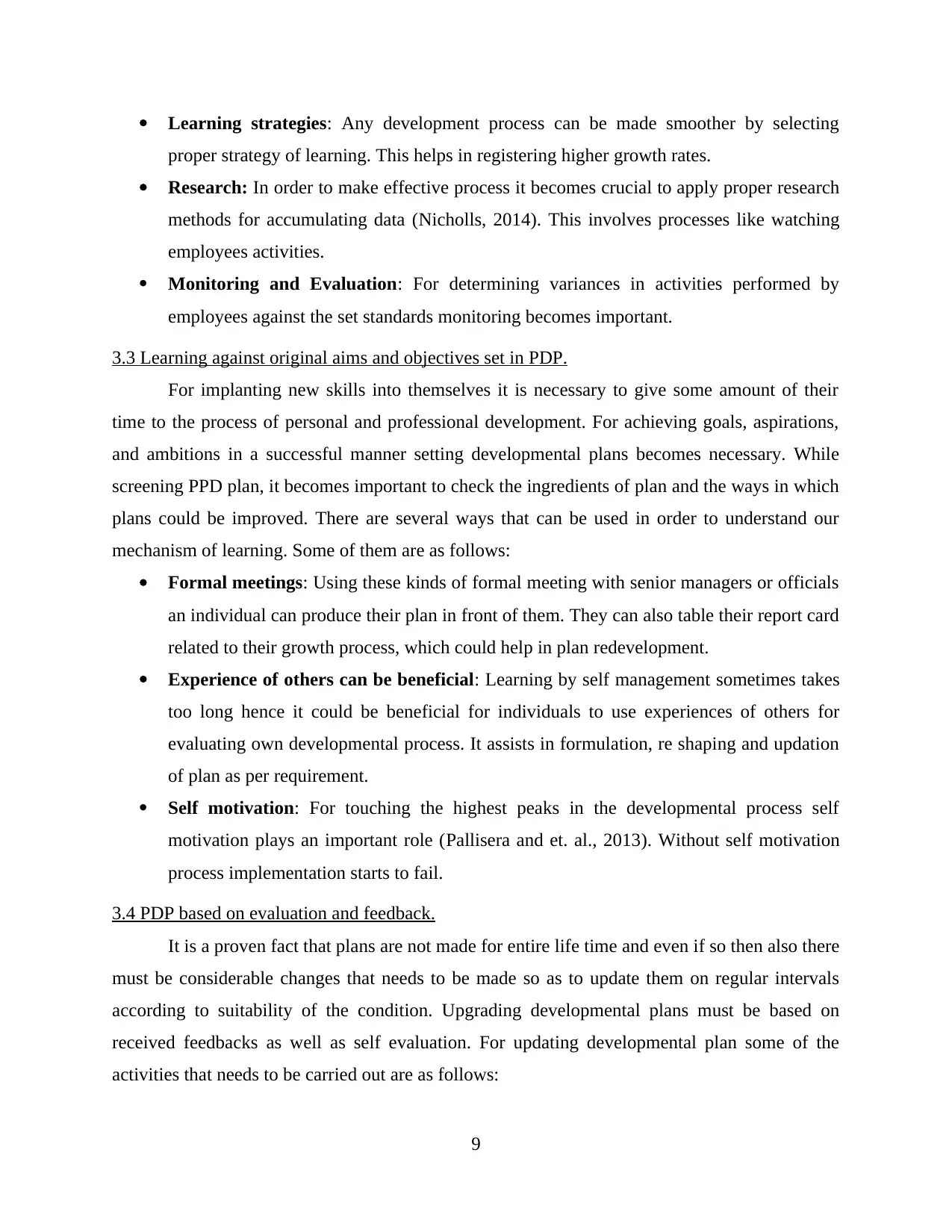
Learning strategies: Any development process can be made smoother by selecting
proper strategy of learning. This helps in registering higher growth rates.
Research: In order to make effective process it becomes crucial to apply proper research
methods for accumulating data (Nicholls, 2014). This involves processes like watching
employees activities.
Monitoring and Evaluation: For determining variances in activities performed by
employees against the set standards monitoring becomes important.
3.3 Learning against original aims and objectives set in PDP.
For implanting new skills into themselves it is necessary to give some amount of their
time to the process of personal and professional development. For achieving goals, aspirations,
and ambitions in a successful manner setting developmental plans becomes necessary. While
screening PPD plan, it becomes important to check the ingredients of plan and the ways in which
plans could be improved. There are several ways that can be used in order to understand our
mechanism of learning. Some of them are as follows:
Formal meetings: Using these kinds of formal meeting with senior managers or officials
an individual can produce their plan in front of them. They can also table their report card
related to their growth process, which could help in plan redevelopment.
Experience of others can be beneficial: Learning by self management sometimes takes
too long hence it could be beneficial for individuals to use experiences of others for
evaluating own developmental process. It assists in formulation, re shaping and updation
of plan as per requirement.
Self motivation: For touching the highest peaks in the developmental process self
motivation plays an important role (Pallisera and et. al., 2013). Without self motivation
process implementation starts to fail.
3.4 PDP based on evaluation and feedback.
It is a proven fact that plans are not made for entire life time and even if so then also there
must be considerable changes that needs to be made so as to update them on regular intervals
according to suitability of the condition. Upgrading developmental plans must be based on
received feedbacks as well as self evaluation. For updating developmental plan some of the
activities that needs to be carried out are as follows:
9
proper strategy of learning. This helps in registering higher growth rates.
Research: In order to make effective process it becomes crucial to apply proper research
methods for accumulating data (Nicholls, 2014). This involves processes like watching
employees activities.
Monitoring and Evaluation: For determining variances in activities performed by
employees against the set standards monitoring becomes important.
3.3 Learning against original aims and objectives set in PDP.
For implanting new skills into themselves it is necessary to give some amount of their
time to the process of personal and professional development. For achieving goals, aspirations,
and ambitions in a successful manner setting developmental plans becomes necessary. While
screening PPD plan, it becomes important to check the ingredients of plan and the ways in which
plans could be improved. There are several ways that can be used in order to understand our
mechanism of learning. Some of them are as follows:
Formal meetings: Using these kinds of formal meeting with senior managers or officials
an individual can produce their plan in front of them. They can also table their report card
related to their growth process, which could help in plan redevelopment.
Experience of others can be beneficial: Learning by self management sometimes takes
too long hence it could be beneficial for individuals to use experiences of others for
evaluating own developmental process. It assists in formulation, re shaping and updation
of plan as per requirement.
Self motivation: For touching the highest peaks in the developmental process self
motivation plays an important role (Pallisera and et. al., 2013). Without self motivation
process implementation starts to fail.
3.4 PDP based on evaluation and feedback.
It is a proven fact that plans are not made for entire life time and even if so then also there
must be considerable changes that needs to be made so as to update them on regular intervals
according to suitability of the condition. Upgrading developmental plans must be based on
received feedbacks as well as self evaluation. For updating developmental plan some of the
activities that needs to be carried out are as follows:
9

Changing training
methodology
Different approaches Motivational requirement:
It is necessary for employees
to change their methods of
training after evaluating what
kind of changes are required so
as to remove the flaws present
in the plan.
For making learning process
efficient and effective, it
becomes crucial for workers to
implement various styles or
approaches (Reeves, 2012).
Future issues can be resolved
easily if multi variant plans
gets adopted which is
empowered by using different
plans.
To develop attributes that
helps in professional life
Higher motivational levels are
required.
TASK 4
4.1 Work based problem and its solution.
While performing various activities at the workplace, there can be chances of generation
of various work related problems. All these problems needs to made aside in order to enhance
individual's growth rate and also increasing the productivity of firm. One such problem and its
solution is presented below:
Working as a team: In modern era of business environment working in team has became
important. It not only increases efficiency of processes but also enhances the quality of both
process and final product (Rienties, Brouwer and Lygo-Baker, 2013). As it eliminates minor
mistakes that could be done when working alone. It helps individuals in learning from the
knowledge of others. In past few years due to internal competitiveness among employees they
are not understanding the benefits of working as a team. In order to remove this situation
activities are as follows:
Developing channels of communication: Management has a role of formulating and
maintaining channels of communication. It is important for the making information flow
smoother.
10
methodology
Different approaches Motivational requirement:
It is necessary for employees
to change their methods of
training after evaluating what
kind of changes are required so
as to remove the flaws present
in the plan.
For making learning process
efficient and effective, it
becomes crucial for workers to
implement various styles or
approaches (Reeves, 2012).
Future issues can be resolved
easily if multi variant plans
gets adopted which is
empowered by using different
plans.
To develop attributes that
helps in professional life
Higher motivational levels are
required.
TASK 4
4.1 Work based problem and its solution.
While performing various activities at the workplace, there can be chances of generation
of various work related problems. All these problems needs to made aside in order to enhance
individual's growth rate and also increasing the productivity of firm. One such problem and its
solution is presented below:
Working as a team: In modern era of business environment working in team has became
important. It not only increases efficiency of processes but also enhances the quality of both
process and final product (Rienties, Brouwer and Lygo-Baker, 2013). As it eliminates minor
mistakes that could be done when working alone. It helps individuals in learning from the
knowledge of others. In past few years due to internal competitiveness among employees they
are not understanding the benefits of working as a team. In order to remove this situation
activities are as follows:
Developing channels of communication: Management has a role of formulating and
maintaining channels of communication. It is important for the making information flow
smoother.
10
⊘ This is a preview!⊘
Do you want full access?
Subscribe today to unlock all pages.

Trusted by 1+ million students worldwide
1 out of 16
Related Documents
Your All-in-One AI-Powered Toolkit for Academic Success.
+13062052269
info@desklib.com
Available 24*7 on WhatsApp / Email
![[object Object]](/_next/static/media/star-bottom.7253800d.svg)
Unlock your academic potential
Copyright © 2020–2025 A2Z Services. All Rights Reserved. Developed and managed by ZUCOL.




